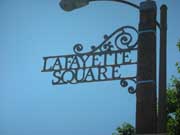Neighborhoods
St. Louis is very much a city of neighborhoods—that’s what makes it so special.
The city is made up of 79 neighborhoods, each with its own look, feel and characteristics. While each may be distinct, they have one thing in common: They all have a strong sense of community. Community organizations, neighborhood associations, and tons of free events are just part of what makes St. Louis, St. Louis.
We focus on properties in the city because we, like you, love everything living downtown has to offer.
Here are just a few of the neighborhoods we serve. Please bear in mind that although we haven’t listed them all, Failoni Consultants can help you with purchasing or renting a property in any St. Louis City area code.
63101 | 63102 | 63103 | 63104 | 63108 | 63113 | 63116 | 63118 |63110

The Central West End is hip, cool and very much a great neighborhood to live in. It’s been described as urban-eclectic with lots of places to walk to including upscale restaurants, art galleries, sidewalk cafes, boutiques and is teaming with neighbors and visitors. It’s got an urban vibe that says bo-ho cool yet sophisticated.

Compton Heights features stunning homes and dates back to one of the earliest planned residential developments in the American 19th century. The over 200 homes in this neighborhood are all part of a local historic district. The houses, as well as the people who live in them, are varied and wonderful.

Is it any wonder that there are many who love the edgy, energetic lifestyle of living in Downtown St. Louis? This neighborhood is one of the most diverse and authentic areas in the amenities it offers. Within walking distance of our beloved Arch, hot spot restaurants and thriving nightlife, art galleries, river front living and city gardens. Take a stroll to a Cardinals’, Blues’ or Rams’ game and then enjoy the fireworks from a roof top deck.

Lafayette Square is the crème de la crème when it comes to Victorian homes. The flamboyance of the last part of the 19th century is very much evident in this beautiful area that was once and is again one of the most fashionable St. Louis neighborhoods.Originally reserved for public use as a pasture and farm land in the European tradition, Lafayette Park, a primary focus of Lafayette Square, today remains the only land within the city never under private ownership. It is also one of the last links to the little French settlement that started in 1764.

The Hill neighborhood is rich with Italian culture, food and fun. The Italian American influence can be enjoyed at the locally owned bakeries, authentic Italian grocery stores and restaurants, bocce ball courts and shops. If you aren't sure you're in The Hill, just check the nearest painted firehydrant for proof of the Italian culture still resonant today. St. Ambrose Catholic Church was built in 1926 and continues to be the backbone of the neighborhood today.

When Henry Shaw discovered this area in 1840, it was an expansive natural prairie. Once he had built his country home, Tower Grove House, he began planning and creating the magnificent Missouri Botanical Gardens. Shaw began dabbling in residential development and Flora Place, the heart of the Shaw neighborhood, was the showcase for this area.Shaw is in the heart of the Garden District and contains a variety of housing, from beautiful grand homes to spacious multifamily dwellings. Residents enjoy a great dog park, the Historic Shaw Art Fair, churches, schools, businesses, and quick access to the Botanical Gardens and Tower Grove Park. A historic preservation area, the homes in Shaw are beautiful, unique and many are in the midst of a renovation renaissance. Neighbors are in close walking distance to farmers’ markets, band concerts, restaurants, bakeries, barbers, health services and retail shopping both in Shaw and in the adjacent South Grand Boulevard area.

Today’s Skinker DeBalieviere Neighborhood is one of the most vital and livable neighborhoods in the metro area. Its roots go back to the 1904 World’s Fair, an event that spurred the rapid development of the institutions and homes in the area. Historic single-family homes on quiet private and public streets, newly constructed town homes in Kingsbury Square, and gracious two-family flats and apartment buildings give the neighborhood diversity. The traditional architectural beauty of that the 1900s along with the modern family lifestyle make this neighborhood a great one.

Soulard was named for Frenchman Antoine Pierre Soulard who came to the area in the late 1790s as a surveyor for the King of Spain. The area today is an economically and culturally-diverse neighborhood featuring one of St. Louis’ biggest and best Farmer’s Market. Soulard is one of the oldest parts of the city with original housing stock dating from the mid- to late 1800s and exhibits a wide range of architectural styles, making it a historic preservation area.

Peaceful and charming are words that best describe the Southampton (SoHa) neighborhood. Tree-lined streets feature a variety of architectural styled homes including Arts & Crafts, Four Square and Neo-Tudors Homes. Neighbors are within walking distance of a vibrant business district that features cafes, delis, restaurants, a theatre, art gallery, grocery stores, a library and more. This neighborhood was recently chosen as residential choice for families in the 25-35 age brackets.

Just as prospective home buyers are attracted to St. Louis Hills for its lovely parks and beautifully landscaped yards, so too are they drawn to its architecture. From the gingerbread bungalows to the stately 2-stores to the sprawling ranches, St. Louis Hills' residences are a study in contrasts and choices. Although many prospective home owners come to St. Louis Hills seeking its classic Tudors and Colonials with their abundant stained glass and ornamental brick and stone work, this neighborhood boasts such a wide variety of architecture that it will appeal to nearly any preference and need.

Just east of Tower Grove Park is one of the strong south St. Louis neighborhoods that are rich in community spirit and architectural styles. Tower Grove East has a true neighborhood vibe, and it is common to bump into your neighbors at the local shops and restaurants. Tower Grove East is adjacent to the South Grand area centered at Grand and Arsenal.

A diverse area, Tower Grove South is nestled between Tower Grove Park, the vibrant South Grand business district, and the growing Morgan Ford and Gravois business districts. This neighborhood offers a balance of homeowners and renters, and you don't need to go much further to find anything you might need.
Featuring a broad range of architectural types, the neighborhood features stately mansions to modest turn of the century two-family flats, art deco apartment buildings and everything in between.

